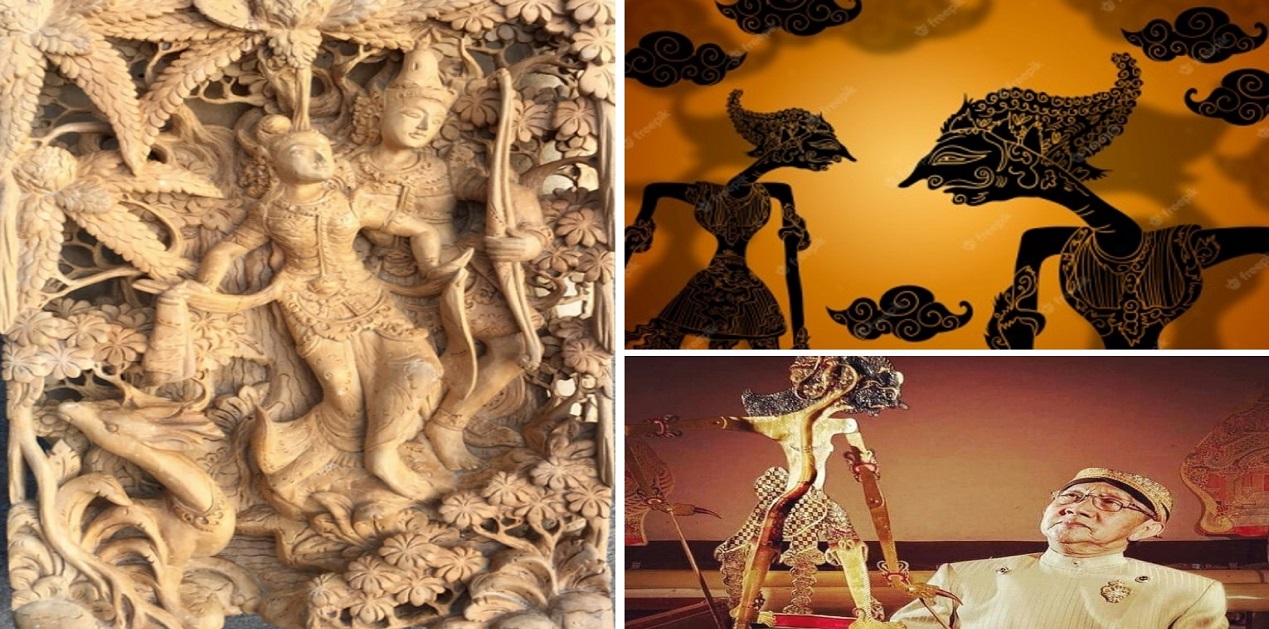Abstract
This article examines the often overlooked yet profound connection between India and Indonesia, grounded in the shared heritage of Indian epics. The article explores how the resonance of Indian epics serves as a potent bridge, fostering understanding, collaboration, and appreciation between the two nations by highlighting the historical interactions and cultural exchanges. By examining the influence of these timeless narratives and their potential to transcend borders, this piece illuminates the power of cultural heritage, which could be applied as a solid tool for understanding Indonesia and the profound knowledge tradition of India.
Introduction
The characters and narratives from the Indian epics have deeply embedded themselves in the consciousness of the Javanese and Balinese people. Java and Bali constitute nearly sixty percent of Indonesia's total population. Within these regions, the embodiment of Indic values is particularly evident in their daily lives, setting them apart from the rest of the country. Retelling the Ramayana and Mahabharata through ballet performances, individual puppetry, skilled woodwork, and creative fabric design brings unity and uniqueness to Indonesian culture. The artistic expressions adorned with imaginative visuals contribute significantly to forging a distinct Indonesian identity.
The Indonesian puppeteers (dalang) ingeniously utilize individual characters from the epics, such as Kumbhakarna, Vibhishana, Hanuman, Sugreeva, Bali in the Ramayana, and Ghatotkachha, Bhima, Arjuna, Abhimanyu, and the offspring of the Kauravas in the Mahabharata. These characters are interwoven into captivating narratives that enthrall the audience, holding their attention for hours. Such expansive literary heritage in practice one may hardly find in India these days.
As depicted in the epics, the characters' traits connect them, fostering communal accord and societal stability. The performers, notably the puppeteers and ballet artists who often draw inspiration from the narratives of these epics, effortlessly captivate the audience with their boundless creativity. This connection is heightened by the fact that the audience is already familiar with the stories, almost as if they are a shared cultural norm within Indonesian society.
The common populace of these islands are committed to preserving their tangible heritage, and the strong support they receive for this cause empowers them to protect their cultural legacy even in the face of the rapid changes brought about by modern life. Despite the increasing influence of the digital world, often referred to as "dunia maya" in Indonesian, these island communities have taken on the responsibility of upholding their cultural traditions and values. This dedication reflects their recognition of the significance of safeguarding their heritage amidst the challenges of the present era.
The anticipation and interest of the audience are sustained not by the element of surprise in the plot but by the dynamic expression of the performance and its relevance to contemporary social life. This skill is achieved through the long practice under the guru-shishya parampara of storytelling of the dalang, who continually weaves the narrative into the context of the audience's daily experiences. The dalang's ability to link the traditional story with current social issues or events helps keep the content relatable and meaningful. By drawing parallels between the past and the present, the audience gains new perspectives and insights, making the performance a living reflection of their own lives.
Additionally, the infusion of comedy, often led by a group of clowns with a head comedian called Semar, similar to the vidushak in Indian drama, is a source of entertainment and light-heartedness. This comedic element prompts laughter until one's stomach hurts, balancing the performance's more serious aspects.
The themes present in these epics can be traced back to Indonesia in their authentic state, having been preserved for generations. They are a substantial foundation for Indonesia's societal, political, and psychological awareness. Even in Java, where the majority follows Islam, the influence of the Ramayana is discernible across various social dimensions. The Javanese people perceive this tangible heritage as integral to their indigenous wisdom and ancestral legacy. This sentiment arises from their belief that Rama and Sita are their royal forebears, and the monarch is regarded as a reincarnation of Vishnu or a divine symbol, mirroring a similar practice in India. As a result, mutual respect plays a crucial role in their social life. Bapak and Ibu (Bapak is used for father or Mr, and Ibu is for mother or Mrs and Ms) are used by all people barring class or creed. These respectful words in ordinary or extraordinary parlance make social life congenial and less conflictive.
Engrained Conscience
Fascinatingly, some individuals even adopt the roles of Rama, Yudhishthira, or Arjuna to mediate minor conflicts. During my recent stay in East Java, I had the pleasure of meeting Prof. Sa'adi, a university teacher who not only imparts knowledge on religious psychology but also holds the esteemed position of an Indonesian puppetry (Wayang) veteran. His contributions to preserving this Indonesian heritage have earned him numerous social accolades.
Prof. Sa'adi possesses another remarkable talent – he adeptly resolves family and property disputes. Many concerned individuals would visit his residence, patiently awaiting their turn. With deep meditation, Prof. Sa'adi would connect with the spirit of Yudhishthira. Then, as if embodying the character, he would attentively listen to their grievances and deliver judgments that are accepted as divinely inspired decisions.
Sukarno, the first President of Indonesia, often referred to Indian epics in his speeches and writings, emphasizing their relevance to Indonesian culture and national identity. He saw parallels between the struggles in these epics and Indonesia's fight for independence from colonial rule. Additionally, Sukarno was a proponent of the concept of "Nusantara," which refers to the archipelago region of Southeast Asia, and he believed that the Indian epics played a role in shaping the cultural and historical identity of the region.[1] Sukarno was known for his intense appreciation of Indonesia and India's cultural and historical ties.[2]
The essence of mutual respect and harmony is readily apparent in their presentation of the Ramayana Ballet. This elaborate production involves a substantial team, sometimes consisting of up to fifty artists, aside from the crew members. The collective synergy in orchestrating such a grand cultural spectacle mirrors Indonesia's genuine spirit of collaborative teamwork, which is deeply embedded in its cultural ethos.
Social Philosophy
This sense of mutual respect is also evident in the Indonesian social philosophy of Gotong-Royong. Gotong-Royong is a traditional cultural concept that embodies the essence of cooperative collaboration and community solidarity. It involves people coming together voluntarily to collectively work on various tasks, such as communal farming, construction endeavors, or event organization. The term "gotong-royong" originates from Javanese and is widely embraced across the Indonesian archipelago. This cooperative undertaking cultivates a strong feeling of unity, social concord, and shared accountability within the community.
Indeed, this spirit of cooperation likely finds its roots in the susceptibility of Indonesia to natural disasters. In the face of such challenges, village communities often unite to support one another. For instance, if someone loses their home in a disaster, the villagers would join forces to construct a new house. This collective response showcases the innate resilience of Indonesian communities and highlights their readiness to come together in times of adversity to provide aid and assistance.
J Noorduyn, in his article, “Traces of an Old Sundanese Ramayana Tradition," says that around two third of the Javanese Ramayan comes from the Old Javanese version and has been derived from Bhatti-Kavya.[3] He explains how diversity in the story of Ramayana in the Malay and Javanese literature is one of the significant issues in studying Ramayana. Very evident from his research is that, like India story of Ramayana got customized substantially in its oral tradition, which later impacted the written literary version. Compared to Mahabharata, Ramayana is a plain story full of emotions and sacrifices. It negates the direct indulgence in confrontation without having any revengeful intention. It seeks justice on the moral and ethical grounds laid down by contemporary Indian society. Most Indonesian literature often takes a comparative discourse to identify differences between these two epics.
The Ramayana is often seen as a story of righteousness, duty, sacrifice, and devotion revolving around the pivotal theme of the triumph of dharma (righteousness) over adharma (unrighteousness). Despite personal sacrifices, Rama's adherence to duty showcases his moral and ethical character. The narrative strongly emphasizes loyalty, honour, and family bonds.
On the other hand, the Mahabharata is a much more complex and multifaceted epic. It delves into various aspects of human nature, society, and politics. The Mahabharata revolves around the rivalry between two groups of cousins, namely the Pandavas and the Kauravas, and it explores themes like duty, justice, power, and morality. The epic raises intricate moral dilemmas and questions whether the ends justify the means.
While both epics contain elements of emotions, sacrifices, and ethical considerations, the Mahabharata's narrative is characterized by its complexity, moral ambiguity, and exploration of human psychology. The Ramayana, in comparison, is often seen as more straightforward and focused on the principles of righteousness and devotion. That is why Ramayana is more engrained in the folklore of Indonesia, like India.
Penetration of Islam in Sufi Structure
During the early 12th century, the influence of Islam began to make its way into these islands, facilitated by Muslim traders from regions such as Gujarat and various parts of the Middle East. In the local context, the forefront of this propagation was led by a group of pioneering preachers known as the "Nine Sufi Saints," or Wali Songo. These preachers demonstrated a deep understanding of the cultural nuances of the islanders and adapted their teachings accordingly.[4]
Their unique approach drew from the puppetry tradition of Java, a technique rooted in local culture. This tradition was based on Indian epics, and the Wali Songo effectively utilized these familiar stories as a resource for conveying the principles of Islam. By integrating Islamic teachings with cultural elements that resonated with the local population, they effectively communicated the message of Islam and made it relatable to the people of the islands. This approach showcases their innovative method of spreading Islam while acknowledging and incorporating the existing cultural fabric of the islands.[5]
This is why Islam made a distinct identity in Indonesia, barring the Pan-Islamic countries. The approach taken by early Islamic missionaries and scholars, similar to the Wali Songo in Java, contributed to developing a unique Islamic identity in the region. Unlike some Pan-Islamic countries where the predominant Islamic culture has a more standardized or uniform expression, Indonesia's unique Hindu-Buddhist history and diverse cultural landscape allowed for a more localized interpretation and integration of Islam.
The integration of Islamic teachings with local customs, traditions, and cultural elements resonated with the people of Indonesia, leading to the establishment of a form of Islam deeply rooted in the Indonesian context. This cultural adaptation helped create a sense of belonging and ownership among the Indonesian population, making Islam an integral part of their identity while maintaining cultural diversity.
The result is a rich tapestry of Islamic practices, beliefs, and expressions unique to Indonesia. This blend has shaped Indonesia's social, religious, and cultural fabric. It has led to the developing of a vibrant and diverse Islamic culture that sets it apart from other regions with more standardized interpretations of Islam. This unique blend provided substantial leeway for other cultures to develop in Indonesia.
India’s Account of Missing Cognizance
India in the past hardly took serious note of the prospects of soft diplomacy it could leverage on Indonesia. Recognizing and capitalizing on shared cultural heritage, historical connections, and common values can open new avenues for cooperation and collaboration beyond traditional political or economic interactions. It is crucial for countries to continually explore and invest in soft diplomacy strategies, as they can offer more sustainable and enduring benefits in the long term.
While the past has missed some opportunities, the present and future provide a chance to rectify that. The tangible Indic heritage in Indonesia can serve as a powerful bridge for India to strengthen its relationship with one of the largest countries in the Southeast Asian region. Both countries could establish cultural exchange programmes that share traditional art forms, music, dance, and other aspects of their shared heritage. Collaborative projects between artists, performers, and artisans from both countries could promote cultural appreciation and deeper connections between the two nations. They can work together to preserve and promote their shared tangible heritage. This could involve initiatives such as joint conservation projects, the documentation of historical sites, and the protection of traditional art forms that have roots in both countries.
By recognizing and celebrating the common Indic values that underlie social etiquette and civic sense in both countries, India and Indonesia could promote a sense of shared identity and strengthen their cultural bonds.
While there is a long chapter in the history textbooks of Indonesia about the Indian influence on Indonesia's history, the same outstanding reference is missing from Indian texts except for the reference to Sumatra, Java, Bali, Borneo, and Celebes in the Valmiki Ramayana.[6] Indonesia was already in the Ramayana before it went to Indonesia. The extensive Indian influence on Indonesia's history, including trade, cultural exchange, religious interactions, and more, is well-documented in Indonesian historical accounts. This influence is often associated with the spread of Indian culture, art, language, and religions, particularly Hinduism and Buddhism. The historical interactions between India and Indonesia have left a lasting impact on Indonesia's culture and society.
References
[1] McIntyre, A (1973). "The 'Greater Indonesia' Idea of Nationalism in Malaysia and Indonesia ."Modern Asian Studies. 7 (1): 75–83. doi:10.1017/S0026749X0000439X. S2CID 145234977.
[2] Suryanarayan, V. (1981). PRESIDENTIAL ADDRESS: INDIA AND THE INDONESIAN REVOLUTION. Proceedings of the Indian History Congress, 42, 549–562. http://www.jstor.org/stable/44141175
[3] (Noorduyn, J. (1971). Traces of an Old Sundanese Ramayana Tradition. Indonesia, 12, 151–157. https://doi.org/10.2307/3350663)
[4] Jatmika Indrawan Muhammad, The Role of Wayang in TheSpread of Islam in Java, https://www.academia.edu/37010181/The_Role_of_Wayang_in_The_Spread_of_Islam_in_Java
[5] Soenarto (2006). Pengaruh Islam dalam Perwujudan Wayang Kulit Purwa. Jurnal Seni Rupa dan Desain, (03), pp.40-51.
[6] https://www.valmikiramayan.net/utf8/kish/sarga40/kishkindhaitrans40.htm
(The paper is the author’s individual scholastic articulation. The author certifies that the article/paper is original in content, unpublished and it has not been submitted for publication/web upload elsewhere, and that the facts and figures quoted are duly referenced, as needed, and are believed to be correct). (The paper does not necessarily represent the organisational stance... More >>











Post new comment